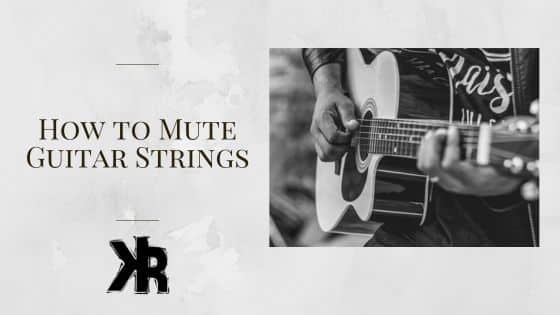Table of Contents
Today, we’re looking into a key area of good technique, muting guitar strings. It might not sound like the most exciting topic, but trust me, it’s crucial to clean and professional guitar playing.
Muting is one of those skills that separates the good players from the truly great ones. The real beauty of guitar playing isn’t just in the sound, it’s also in the silence. And mastering that silence is where string muting comes into play.
Over the course of this Killer Rig article, we’ll explore the ins and outs of muting techniques. We’ll discuss why muting is so important, look at some practical methods, and even look a little into the role of silence in music.
Understanding Guitar String Muting Techniques
String muting is a must-have tool in your guitar playing skill set. It eliminates unwanted noise, allowing your intended notes to take center stage. Let’s look into four essential muting techniques.
The Left-Hand Lift
The left-hand lift is all about control and precision. While playing a note, you gently lift your finger off the fret just enough to cease the vibration, muting the string.
The trick here is to maintain contact with the string to avoid creating additional, unwanted sounds. Practice until the motion is smooth and natural.
The Right-Hand Thumb Muting Mastery
Right-hand thumb muting calls for finesse. This method involves lightly resting your picking hand’s thumb on the lower strings while you play the higher ones.
This prevents the lower strings from unintentionally ringing out. By mastering this technique, you’ll have greater control over your guitar’s resonance, making your music cleaner and clearer.
Pizzicato Mutation Technique
The pizzicato mutation technique entails plucking the string and quickly letting go. The result is a muted, percussive sound that can add a personal touch to your music. It demands delicacy and timing, but the effort to learn it is well worth it.
Fretting Hand Lift Method
Similar to the left-hand lift, the fretting hand lift involves raising all your fingers simultaneously to mute all the strings.
It’s useful when you need a moment of silence between chord changes or at the end of a riff. It calls for practice to get it just right, but it can be an invaluable addition to your guitar-playing arsenal.

Mastering Advanced Muting Techniques
Once you’ve got a handle on the basics, it’s time to take your string muting skills to the next level. Here are three advanced techniques that can further refine your playing and give you even more control over your guitar’s sound.
The Karate Chop
Don’t worry, there’s no actual martial arts involved in this technique. The Karate Chop gets its name from the position your hand takes when employing it.
When playing power chords or palm-muted riffs, you’ll find that the edge of your palm naturally rests on the strings.
That’s the Karate Chop. It’s great for controlling unwanted noise, especially on the lower strings. Mastering it allows you to deliver those hard-hitting riffs without any extra string noise muddying up your sound.
The Plant Method
The Plant Method is all about stability and control. When plucking individual notes or arpeggios, it’s handy to have a reference point on the guitar. This is where the Plant Method comes in.
Here, you lightly rest one or more fingers on the body of the guitar or the lower strings (if they’re not being played). While providing a stable base from which to pluck the strings.
This can significantly improve your accuracy and speed, as well as help control string noise.
The Fading Technique
The Fading Technique is a bit more nuanced and requires a good ear and a sensitive touch. The idea is to gradually decrease the pressure you’re applying to the string until the note fades into silence.
This creates a smooth, natural sounding mute that can be very effective in softer, more melodic passages. It’s a subtle coordination, but when used correctly, it can add a whole new level of expression to your playing.
These advanced techniques require a bit more practice and dexterity than the basic ones, but they offer a greater level of control and can make your playing sound more professional and polished.
Muting Strings During Sweep Picking
Sweep picking is a beautiful technique that can make your guitar sing like a harp. It involves playing a rapid series of notes on consecutive strings with a ‘sweeping’ motion of the pick.
But with all those strings vibrating at once, things can quickly turn into an unruly clatter if you don’t apply proper muting techniques.
Understanding Sweep Picking
First, understanding the mechanics of sweep picking is crucial. It’s all about economy of motion, the pick moves in a single, continuous direction across the strings, like a gentle broom (hence the term ‘sweep’).
The challenge here is to let each note ring out cleanly without them bleeding into one another.
Methods for Muting Strings During Sweep Picking
To achieve a clear sound, you need to simultaneously play one note while muting the others. And that’s where your fretting and picking hands come into play:
- Fretting Hand Roll: As you move from one string to another, your fretting hand should ‘roll’ from one string to the next. Just enough to mute the string you’ve just played. It requires a delicate balance. You need to lift your finger off the string enough to stop it vibrating, but not so much that it rings out.
- Picking Hand Palm Mute: At the same time, your picking hand should be lightly resting on the strings that are lower (in pitch) than the one you’re playing. This effectively mutes these strings and prevents them from ringing out unintentionally.
The key to successful sweep picking is synchronization between both hands. Each note should be clear and well defined, with no overlap or bleed from the other strings.
It’s a tough technique to master, requiring a delicate touch and perfect timing. But with practice, you can achieve beautiful, flowing arpeggios with each note standing out clearly.
How to Avoid Muting Nearby Strings
A common hurdle that many guitarists face is accidentally muting strings adjacent to the one they’re playing.
Strategic muting is an essential part of clean guitar playing. But unintentional muting can lead to lost notes and a muddy sound. Let’s look at how to tackle this issue.
Fingers Positioning
The issue often boils down to finger positioning. When fretting a note, it’s easy for a part of your finger to accidentally touch and mute a nearby string. To avoid this, focus on keeping your fingers upright and using the very tips to press down on the strings.
Hand Posture
Hand posture also plays a big part. Your fretting hand’s thumb should be resting against the back of the neck, allowing your fingers to arch over the strings. This position offers more control and reduces the chance of accidentally muting nearby strings.
Patience
Like all aspects of guitar playing, avoiding unintentional muting requires practice. Start slow, pay close attention to your technique, and gradually increase your speed as you become more comfortable.
Remember, it’s about precision, not speed. Mistakes are part of the learning process. They’re not a sign that you’re doing something wrong, but rather that you’re on the path to doing it right.
So, keep at it. With time and persistence, you’ll be able to fret notes cleanly without muting those nearby strings.

Choosing the Best Muting Execution for Your Style
Finding the best string muting execution for your style of play is a personal realization, one that will likely involve a mix of the methods we’ve discussed.
Different styles of music and playing situations call for certain muting techniques, so the more you learn, the more tools you’ll have in your toolkit.
Aligning Techniques with Your Musical Style
Rock and metal players, for instance, may rely heavily on the Karate Chop for their chuggy power chord riffs.
While classical and fingerstyle guitarists might employ the Pizzicato Mutation Technique or The Plant Method to provide cleaner, more articulate phrases.
Jazz players, on the other hand, might find the Fading Technique useful to add some nuance and expressiveness to their solos.
Muting Techniques and Musical Expressiveness
Remember, muting isn’t just about stopping unwanted noise, it’s also a way to add expressiveness to your playing. A perfectly timed mute can create a sense of space and rhythm, adding an extra layer of texture to your music.
The Fading Technique, for instance, can add a lot of emotion to a solo by letting notes slowly fade into silence.
Practice Makes Perfect
As with any guitar technique, practice is vital. Try out different muting mastery, experiment with them in various musical contexts. See which ones feel the most natural and sound the best to you.
Over time, you’ll develop your own blend of expertise that perfectly complements your style of play.
Finding Your Own Sound
In the end, the best muting technique for you is the one that helps you express yourself most effectively on the guitar. It’s not just about execution, it’s about finding your own sound.
So experiment, practice, and most of all, have fun while becoming a master of guitar string muting.
FAQs
What is the Purpose of Muting Guitar Strings?
String muting serves a dual purpose. First, it prevents unwanted noise by silencing strings that aren’t currently being played.
This results in cleaner, more precise sound. Second, it adds rhythmic elements and dynamic control to your playing. Strategic muting can add texture and depth to your music.
How Can I Practice Muting Techniques?
Start with simple exercises. For example, play a scale while focusing on muting the string you just played. Gradually incorporate more complex muting into your practice routine.
Always start slow, and increase your speed as you become more comfortable. Remember, precision is more important than speed.
How Do I Know If I’m Muting Correctly?
If you’re muting correctly, your playing will sound clean and precise. You won’t hear any unwanted noise or ringing from strings that you’re not currently playing.
It’s helpful to record yourself playing, as it’s often easier to hear mistakes when you’re not focused on playing.

